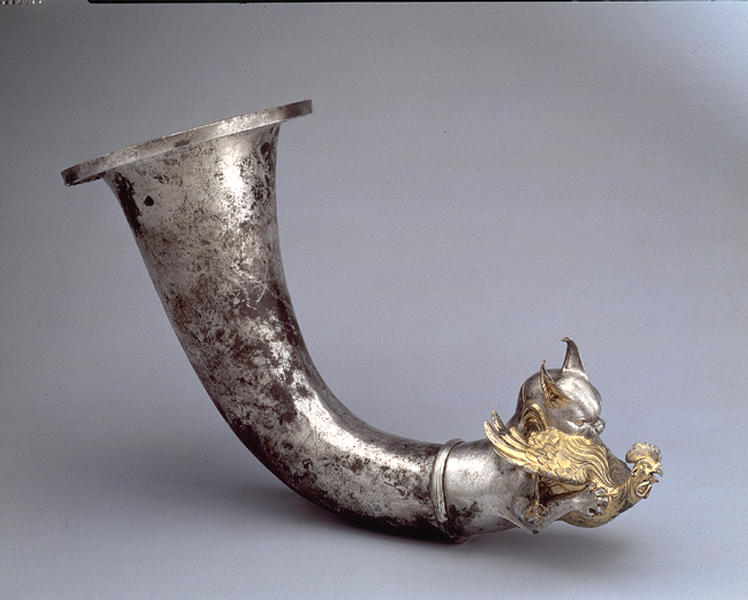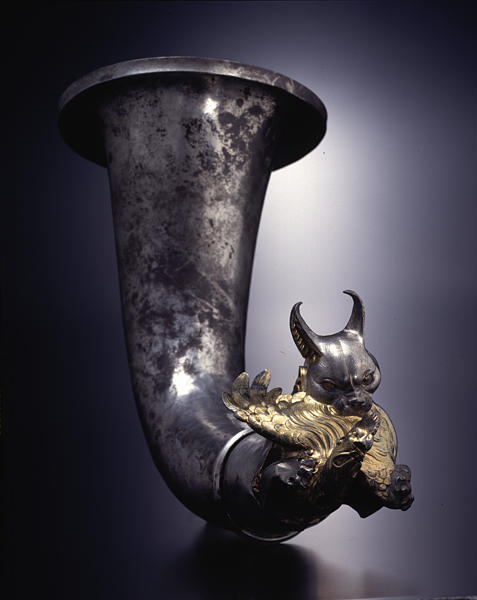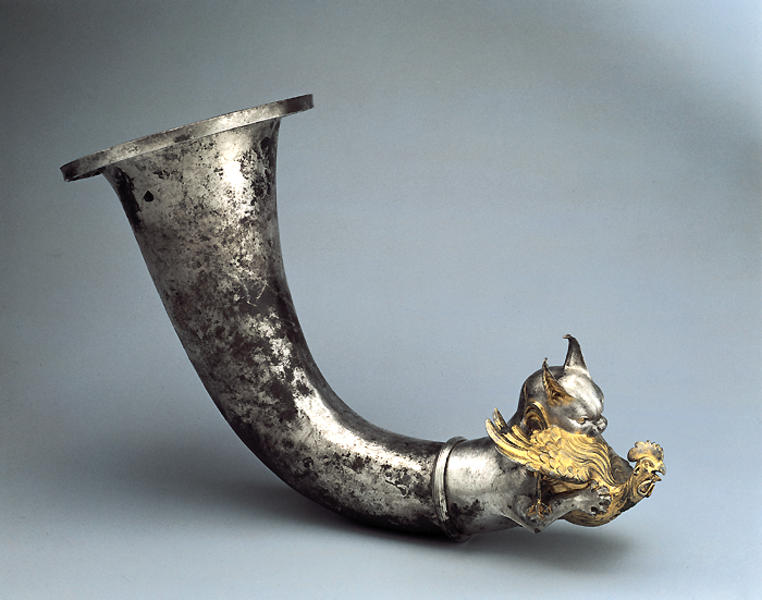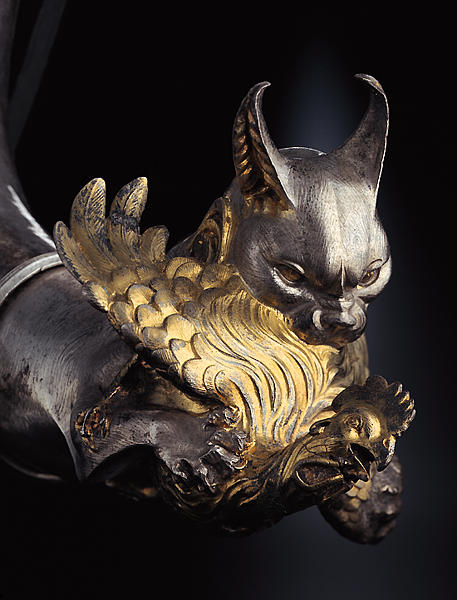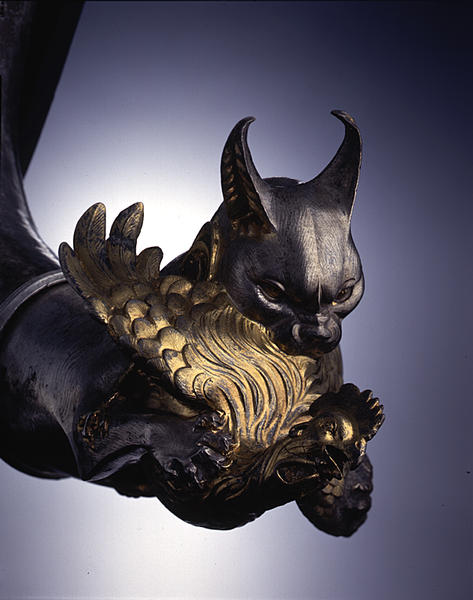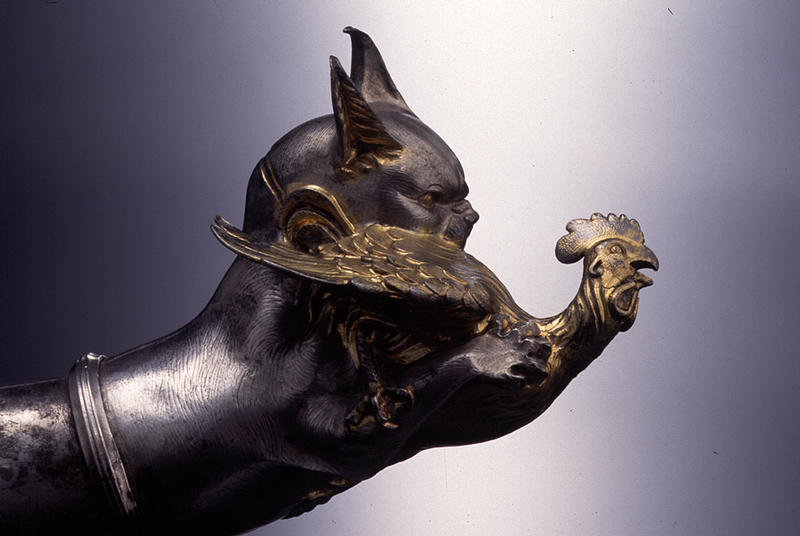鶏を銜える山猫形リュトン
- イラン/中央アジア
- 紀元前2世紀後期-紀元前1世紀
- 鍍金銀(銀鍍金)
- H-41.4 D-15.4
リュトンは西アジア起源で、この型の大山猫型リュトンは多く後期パルティアの時代のものとされるが、この迫真の写実的表現は西アジアには見られない。前半身に刻まれた銘文の数字は全体の重量を示していると考えられ、バクトリア王国初期の重量単位に一致する事から、これは紀元前3-2世紀の作であろう。一説に大山猫のテーマは東征した酒神ディオニュソスと深く関わり、アレクサンダー大王に擬えているとも考えられている。あるいはペルシャを襲うギリシャを象徴したものかも知れない。
描写について
この美しいリュトン、すなわち飲用の角杯は、折り曲げられた狭い外反口縁部をもつ優雅で簡素な角杯部分と、華麗に作り上げられた先端部とが組み合わさっている。先端部はカラカル、すなわちよく砂漠大山猫と呼ばれる猫の一種の形をしており、もがいている雄鶏を足でぎゅっとつかんでいる場面が表現されている猫がわずかに右に体をひねり、鶏の両方の翼が猫の頭の右側に置かれることによって、先端部分の左右相称のバランスはわずかに崩されている。これとは対照的に鶏は左側に体をひねっている。装飾の施されていない湾曲した器表面と、きわめて明瞭に表現された動物の姿との組み合わせは、躍動感のある動きによってその効果が高められており、さらに、猫の立体的な顔および耳の柔毛の描写と、鶏の羽毛、とさか、肉垂の細部の豊かな表現との相互作用が、より一層その効果を強めるはたらきをしている。鶏および猫の眼と耳の内側には鍍金が的確に使われており、この容器を作った銀細工師の卓越した審美眼を証明している。
Catalogue Entry
This stunning rhyton or drinking horn depicts the protome (forepart) of a desert lynx (caracal cat, Felis caracal) clutching a desperate cockerel in his paws. The rhyton is made in two major parts--the horn and separately manufactured protome of the lynx and bird. The slender horn rises to an outturned rim. A spout opens at the breast of the straining bird. The relentless intensity of the predator and the terror of his victim are brilliantly conveyed. The artist vividly alluded to motion by having the cat turn slightly to the right, the direction in which the bird tries to escape. Gilding is used to visually separate the animals. On the lynx it is limited to the eyes, inner ears, and collar, whereas the cock is completely gilded.
From a typological point of view, the idea of a feline catching or devouring his victim is based on an Achaemenid concept.1 An Eastern context for the rhyton is further corroborated by the lynx, because the examples with this animal known to date are almost exclusively linked to the Hellenized Near East. The style, however, follows Greek standards, without the slightest reference to Achaemenid art, making it a telling example of the craftsmanship from the Hellenized Near East.
Rhyta enjoyed a long history in ancient West Asia and were especially popular in the Achaemenid period (mid-sixth-third quarter fourth century B.C.). Lynx rhyta, however, were entirely unknown in the pre-Hellenistic Near Eastern repertoire. As in the case of all other known examples, the cats in this and a second lynx rhyton in the Shumei collection (SF3.034)2 wear a collar around the neck, which shows them to be tamed animals, possibly ones used for hunting by the Eastern nobility. Given the presence of ivy under the rim and a lavish spray of vine around the animal's neck in the second Shumei lynx rhyton--a motif also found on a lynx rhyton in New York--an even more specific background should be considered.3 Not only does the lynx closely resemble a panther, the holy animal of Dionysos, the Greek god of wine, the ivy was likewise a Dionysiac symbol. According to ancient mythology, the symposiastic god conquered the East and even reached India.4 As a conqueror of India, Dionysos must be understood as a divine forerunner of Alexander the Great and his Asian campaigns (335-323 B.C.). Given such Dionysiac aspects, we should see the lynx-panther rhyta as an allegory of Graeco-Macedonian dominance over the collapsed Achaemenid Empire. The Dionysian affiliation makes it rather unlikely that all these rhyta should be entirely limited to late Hellenistic days, when the Central Asian Parthians had already erased Greek power from Iran to Mesopotamia, but archaeological clues for an earlier dating are presently lacking.
This brilliant rhyton with lynx and cockerel must be understood as a variant of such Near Eastern lynx rhyta. All are without any recorded provenance. Two pieces in the J. Paul Getty Museum have been dated to the 1st century B.C. on the basis of their Aramaic inscriptions.5 Our rhyton carries two inscriptions studied by P.O. Skjaervo,6 the second gives the number 34. This should be a weight inscription, referring to a coin standard, but it may be one that differs from the standard used for the Getty vessels, which is based on a multiplier of 4. In this case a multiplier of 4 is much too small, and consequently Skjaervo suggested that this weight inscription may possibly refer only to the horn cup of the rhyton. One might consider, however, the hexa-chalkons (copper coins) of Demetrius I of Bactria (about 205-171 B.C.), the famous conqueror of India.7 The weight of one of these coins is approximately 25.5 grams, which multiplied by 34 (867 g) gives almost precisely the weight of the vessel (877.2 g). This is only a possibility and should not be taken to imply a definite clue towards absolute chronology, although historical and mythological considerations may actually point to an expansion of the chronological range beyond the usual preference for a late Hellenistic dating.
MP
1. See, for example, a rhyton with a protome of a lion catching an antelope, of Egyptian faience, which is in truly Achaemenid style, Paris, Louvre E 931: Roes 1952, pp. 17-20, fig. 4; and a unique glass rhyton from Persepolis, now in Teheran, of a lion killing a bull: Ghirshman 1961, p. 40, fig. 3. 4; Ghirshman 1962, pp. 77, fig. 26.
2. The second rhyton (reproduced Los Angeles County Museum 1996, n.p.) belongs to a well-documented group named "calyx class" after the leaf calyx behind the protomes. The calyx closely resembles the foliage on a lion rhyton of alleged Near Eastern provenance in the J. Paul Getty Museum, Malibu: Pfrommer 1993, pp. 47-48, 178-79, with ill; as well as on a rhyton with the protome of a cebu bull in the Toledo Museum of Art, 1988.23: Knudsen and Luckner 1991, pp. 115-18, figs. 1,2.
3. New York, Metropolitan Museum of Art 1979.447 (Parthian, about first century B.C.): Harper 1984, p. 16, fig. 13; Harper 1987, pp. 350-351, fig. 98; Pfrommer 1993, p. 48.
4. See, for example, Diodorus I.19, 1-5.
5. Pfrommer 1993, pp. 186-87, 190-91, no. 71, 73, with ills.
6. Metropolitan Museum 1996, p. 190.
7. Mitchiner 1975/76, vol. 1, p. 59, no. 107 (hexa-chalkon = 25.42 g).
解説(古代バクトリア遺宝展)
29山猫形リュトン
前1世紀
鍍金銀
長44.0 cm 口径15.0 cm
30鶏を銜える山猫形リュトン
前2世紀後期―前1世紀
鍍金銀
長41.4 cm 口径15.2-15.4 cm
作品30の銀製リュトンはその端に鶏を銜える大山猫の前半身をつけ、鶏の胸部を注口としている。鶏の全身を鍍金することによって山猫と明確に区別をし、山猫には目と耳の内側を鍍金して表情を与えている。この長い耳の尖った先端がやや内側に翻るような力のこもった大山猫の意匠は、紀元前後のヘレニズム世界の宝飾品にもいくつか類例が知られている。このリュトンの大山猫は鍍金をした首輪をしているが、これは当時狩猟用に飼いならされていたことを示すものであろう。大山猫はディオニュソスの獣、豹としばしば同一視されたが、この獣の前半身をつけた銀製リュトンは他にもいくつか類例が知られ、作品29に見られるように器や山猫の体躯に蔦、葡萄の意匠を施したものがあり、ディオニュソス祭祀と深い関係のあったことが分かる。そしてディオニュソスの秘儀にはこのような猫科の猛獣・・豹や大山猫の形をつけたリュトンが儀器として深くかかわっていたことが知られている。アメリカのポール・ゲッティー美術館やサックラー・ギャラリーの類例は、体躯の毛並み表現の他、肩に一種の渦巻く放射状の意匠を施してあるが、作品29、30の大山猫には渦巻く毛並み表現は見られるものの、この類の渦巻文は見られない。猛烈な勢いで鶏に襲いかかり貪る山猫と今にも息絶えそうな鶏といった迫真の表現は紛れもなくギリシャ由来の職人技であるが、猛獣とその獲物を組み合わせる意匠は西アジアのものである。
山猫形リュトン
Catalogue Entry(Bac#029,030)
29
Lynx Rhyton
1st century B.C.
Gilded silver
L. 44.0 cm, Mouth dia. 15.0 cm
30
Rhyton with the Protome of a Desert
Lynx Catching a Fowl
Late 2nd‐1st century B.C.
Gilded silver
L. 41.4 cm, Mouth dia. 15.2-15.4 cm
The silver rhyton at no. 30 shows the forequarters of a desert lynx catching a fowl in its paws, while the chest of the bird forms the spout. The entire figure of the bird is gilded and contrasts clearly with the cat's form, while the cat's eyes and the insides of its ears are also gilded. The long ears are pointed at their tips and curve in slightly as part of the expression of this powerful cat. There are several examples of Hellenistic jewelry with similar cat motifs from around the time of Christ. This cat is wearing a gilded collar, and this probably indicates that such animals were kept for hunting purposes during this period. The desert lynx is a Dionysian beast, and it is frequently shown alongside leopards. There are also several similar examples of rhyta with attached animal forequarters, and as can be seen in cat. No. 29, the lynx's body is decorated with vine and grape motifs, clearly indicating a deep relationship with the rites of Dionysus. And we know that the mystery of Dionysus included ritual vessels featuring this kind of hunting cat, such as a leopard or lynx. Similar examples in the J. Paul Getty Museum and the Sackler Gallery have the same kind of hair depiction on the animals' body, and a spiral motif on their shoulders. The curling hair motif on the lynxes on cat. Nos. 29 and 30 are not the same kind of motif. The lynx violently plunging and capturing the bird in such amazingly life-like form that we can almost feel the bird's surprise. A Greek craftsman with unparalleled skill created this motif which, in fact, originated in west Asia.
山猫形リュトン
鶏を銜える山猫形リュトン
獲物をしっかりと捕らえるカラカルの鋭い眼差しと強剛な前脚。目が裏返り必死に抵抗する鶏の叫び ― これはただ事ではない。ここまで迫真の生死の営みを写した器があっただろうか。自然の原文に肉薄する造形の超越。
古代イランでカラカルは鳥の狩猟に使われた。鍍金の首輪がそれを証す。遊牧のサルマタイの注文か、角杯の銘文は彼らが使っていた重量単位を含んでいる。
中央アジアに根付いたギリシア人の工房は、時に注文主の想像力をはるかに凌駕する奇跡を産み出したのかも知れない。
Rhyton with the Protome of a Desert Lynx Catching a Fowl
Eyes blazing, the lynx (caracal) firmly grasps its prey. The cockerel screams in desperation, eyelids flipped as its fate is sealed. Is there any other piece in the world that captures the workings of life and death with such arresting power? It is a superlative figure encapsulating the law of nature.
The caracal is known to have been used in hunting fowl in the ancient Orient, and the gilt gold of the collar seems to confirm this. The inscriptions on the rhyton indicate it was ordered by a nomadic Sarmatian, as the inscriptions include a unit of weight used by that tribe.
The Grecian artisans who had settled in Central Asia must sometimes have produced pieces that far surpassed the imagination of the customer.
